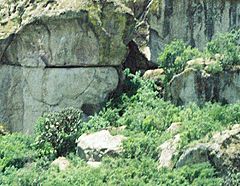Guilá Naquitz Cave facts for kids

the collapsed cave's rock face with exposed paintings
|
|
| Location | Near Yagul Archaeological Ruins, Oaxaca |
|---|---|
| Region | Mexico |
| Coordinates | 16°58′31″N 96°18′32″W / 16.97528°N 96.30889°W |
The Guilá Naquitz Cave is a very important cave in Oaxaca, Mexico. It's famous because scientists found the earliest signs of plants being grown by people here. This process is called domestication.
Some of the first plants grown here were teosinte, which is an old type of maize (corn). People also grew squash, bottle gourds, and beans. This cave holds the oldest proof that any crop was domesticated in the Americas. It's also where the earliest signs of corn being grown were found.
Scientists found old plant remains, called macrofossils, for both corn and squash in the cave. However, other studies suggest that corn might have first been grown in a different part of Mexico.
Contents
Where is Guilá Naquitz Cave Located?
The cave is about 5 km (3 mi) northwest of Mitla. It sits at the bottom of a tall cliff, which rises 300 m (984 ft) above a dry valley. The cave is 1,926 m (6,319 ft) above sea level.
The entrance to the cave is quite large, about 8 by 10 m (26 by 33 ft). Inside, there are five layers of soil, called strata, that go as deep as 140 cm (55 in). The cave is located at the far eastern end of the Oaxaca Valley.
Who Lived in the Cave?
The first signs of humans living in Guilá Naquitz Cave date back about 10,750 years ago. However, people didn't live there all the time or all year round. Humans stopped living in the cave around 500 years ago.
People lived in the cave during six different periods. The first period was from about 10,750 to 8,900 years ago. Then, people returned much later, from about 1,300 to 500 years ago. The early people were hunter-gatherers. This means they hunted animals and gathered wild plants for food. They lived in the cave only during the months of August to October or December.
How Crops Were Domesticated
The oldest known evidence of Cucurbita (the plant family that includes squash) being domesticated is from 8,000 to 10,750 years ago. This happened even before corn and beans were domesticated in the area, by about 4,000 years. This important evidence was found in Guilá Naquitz Cave and four other caves in Mexico. These discoveries were made during excavations that started around 1959.
More digging at the Guilá Naquitz site happened in the 1970s. A team led by Kent V. Flannery from the University of Michigan carried out this work. Later, scientists used a more accurate dating method called accelerator mass spectrometry. This gave them more exact dates for the findings.
Strong proof of domesticated Cucurbita pepo (a type of squash) was found in the cave. As time went on, the squash rinds became thicker, and their stems (called peduncles) grew larger. These changes were seen in the newer layers of soil in the cave. By about 8,000 years ago, the stems of Cucurbita pepo found were always thicker than 10 mm (0.4 in). Wild squash stems are always thinner than this.
Changes in the shape and color of the squash fruit also showed that people were intentionally breeding Cucurbita pepo by 8,000 years ago. During the same time, the average rind thickness grew from 0.84 mm (0.03 in) to 1.15 mm (0.04 in).
The process of learning how to grow and domesticate crops took a very long time in Mesoamerica, about 5,000 to 6,500 years. Squash was domesticated first. Then came corn, and after that, beans. These three crops later became part of a special farming method called the Three Sisters agricultural system. In this system, corn, beans, and squash are grown together because they help each other grow.
See also
 In Spanish: Guilá Naquitz para niños
In Spanish: Guilá Naquitz para niños


